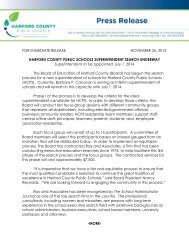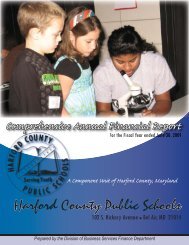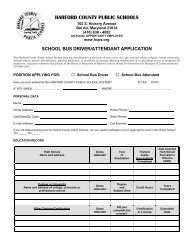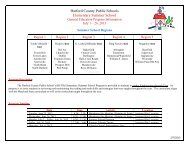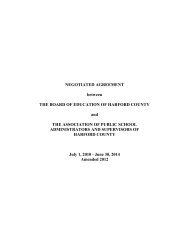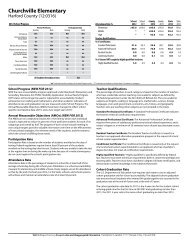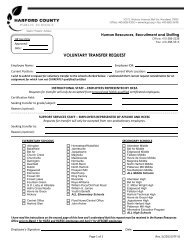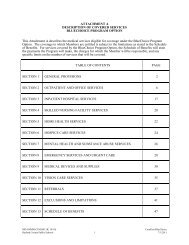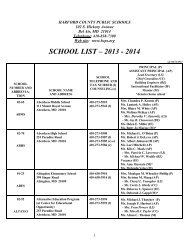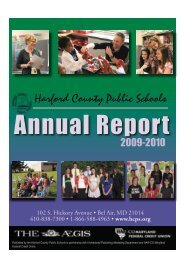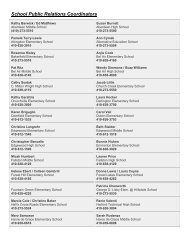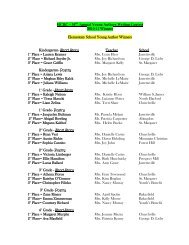Parent Handbook - Harford County Public Schools
Parent Handbook - Harford County Public Schools
Parent Handbook - Harford County Public Schools
You also want an ePaper? Increase the reach of your titles
YUMPU automatically turns print PDFs into web optimized ePapers that Google loves.
following steps:<br />
1. For the child to be considered for advanced placement to first grade, the child must<br />
turn six years old by October 15th and be a resident of <strong>Harford</strong> <strong>County</strong>.<br />
2. The application process begins the first Friday of May and ends the first Friday in June.<br />
Assessments will be administered in May and June of the current school year.<br />
3. Obtain a packet for Advanced Placement into First Grade from the attendance<br />
area school and complete a <strong>Parent</strong> Information Profile and other forms. Complete<br />
the profile packet and return it to the Executive Director of Elementary School<br />
Performance, 102 S. Hickory Ave., Bel Air, Maryland 21014. For consideration, all<br />
information must be complete with parent signatures.<br />
4. After reviewing the information you provide, the Executive Director will make a<br />
decision to honor or decline your request and notify you. If your request is honored,<br />
the information will be kept on file until the child completes the assessment part of<br />
the application packet.<br />
5. If you wish to pursue advanced placement for your child, (s)he will be given a<br />
reading and language arts assessment as well as a mathematics assessment. A<br />
specialist will contact the parent/guardian to schedule the assessment.<br />
6. In order to be considered for advanced placement, your child must score at least<br />
90 percent on both parts of the assessment. Assessments are administered by the<br />
specialist without parent or guardian presence and lasts approximately two hours. A<br />
child may be assessed only one time for advanced placement determination.<br />
7. If advanced placement is recommended, the principal or designee of the attendance<br />
school will schedule a conference with the parent/guardian to discuss the request.<br />
Be prepared to talk about your child’s previous group experiences and special<br />
strengths and needs as you have described them on the <strong>Parent</strong> Information Profile.<br />
8. Placement will be for a probationary period of 30 school days pending the child’s<br />
satisfactory social-emotional adjustment as determined by the classroom teacher.<br />
9. Upon completion of the probationary period, a final letter will be sent to the parent/<br />
guardian. If acceptance into first grade is recommended, all relevant school policies<br />
and procedures will apply including daily school attendance. However, if the child is<br />
denied advanced placement into first grade, the child will be placed in kindergarten.<br />
The intent of the above procedure is to make the first grade program available to younger<br />
students who are capable of working in a classroom setting with children one year older.<br />
The standards for advanced placement in first grade are very high to ensure that children<br />
are not frustrated by the advanced placement.<br />
Alcohol/Metal Detectors & Surveillance Cameras<br />
As a means of further enhancing school safety and security, school administrators have<br />
been trained in the use of a device that detects the odor of alcohol and in the use of<br />
hand-held metal detectors. With reasonable suspicion, students may be subject to the<br />
use of the alcohol-detecting device or the metal detector during the school day or at after<br />
school events on school property. Also, some schools and buses may be equipped with<br />
surveillance cameras. These cameras are placed in interior common areas and outdoor<br />
locations surrounding the building to help monitor student behavior.<br />
Alternative Education<br />
A program of alternative education is provided at the Center for Educational Opportunity.<br />
Secondary school students who have long-term suspensions from school are eligible<br />
to enroll in the alternative education program and will receive credit for satisfactorily<br />
completed work. In addition, secondary school students whose educational, emotional, financial, physical, or other<br />
needs are such that they cannot be met in the regular school program are eligible to apply for admission to the<br />
alternative program.<br />
Attendance Policy<br />
The <strong>Harford</strong> <strong>County</strong> <strong>Public</strong> <strong>Schools</strong>’ Student Attendance Policy is based on the overriding premise that success<br />
in school is dependent upon continuous and consistent classroom instructional experience. In addition to<br />
participating in educational experiences that cannot be duplicated outside the school atmosphere, students<br />
need opportunities to develop an appropriate sense of self-worth and to establish satisfactory peer relationships.<br />
<strong>Schools</strong> are being held accountable not only for effectiveness in teaching state selected curricula, but for the<br />
regular attendance of students.<br />
• Students should be expected to attend school and all classes regularly and to be punctual. Upon returning to<br />
school from an absence, a student is required to bring a written note from his or her parent/caretaker stating<br />
the reason for each absence.<br />
• There is a significant relationship between regular attendance and academic achievement and completion of<br />
a school program.<br />
• Regular attendance assists students in the development of self-discipline and good work habits. These<br />
habits generally remain with the students as they enter the world of work. It is essential to teach the benefits<br />
of and encourage good attendance and punctuality during a student’s educational career.<br />
• Regular attendance is a shared responsibility by the community, the home, students, and school personnel,<br />
and we must work together to promote it to the fullest extent possible.<br />
Rules, Regulations, and Procedures<br />
I. General Regulations Attendance<br />
A. Each child who resides in this state and is five years old or older and under 16 years of age<br />
shall attend a public school regularly during the entire school year unless the child is otherwise<br />
receiving regular, thorough instruction during the school year in the studies usually taught in the<br />
public schools to children of the same age.<br />
B. A student is considered in attendance at school when participating in school-sponsored activities<br />
during the school day, and when that participation is approved by the local superintendent of<br />
schools or the school principal, or their designees.<br />
C. Students Scheduled for a Full Day - A student is counted present for a full day if the student is<br />
in attendance four hours or more of the school day. A student is counted present<br />
half day if in attendance for at least two hours of the school day, but less than four hours.<br />
A student is counted as tardy to school if the student is absent less than 2 ½ hours in<br />
the morning. A student is counted as early dismissal if the student is absent less than 2 ½ hours<br />
before dismissal.<br />
D. Modified School Day (due to inclement weather or elementary planning day) - A student is<br />
counted present for a full day if absent no more than 30 minutes of the school day. A student<br />
is counted present for half day if present for at least two hours. A student is tardy to school if<br />
absent less than 30 minutes in the morning. A student is counted as early dismissal if absent less<br />
than 30 minutes before dismissal.<br />
E. Modified Student Schedule - A student scheduled for less than a full day is to be counted present<br />
based on the amount of time he/she is scheduled. Example: A student scheduled for a two hour<br />
block of time will be counted present for a full day if the student is in attendance for that entire<br />
block of time. If the student is absent for that entire block of time, the student will be counted<br />
absent for a full day. A student scheduled for a two hour block of time will be counted present for<br />
1/2 day if the student is in attendance for one hour.<br />
2



